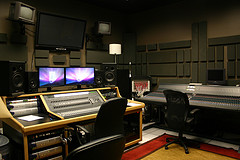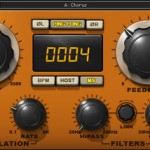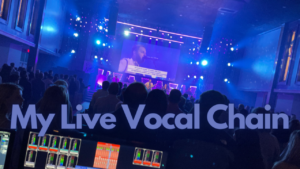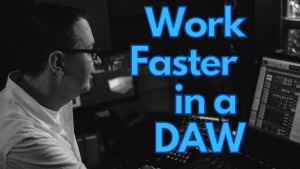
Studio Tanning: Fool Your Brain? – Part 2
In the first part of this series I talked about how mono probably isn’t dead, stereo might not be what we think it is, and the public probably doesn’t care about either. This time out I’m going to get into the nitty-gritty of how I approach imaging in the studio. Let me emphasize up front that this relates to the studio and will be quite counter to my Imaging Expectations post about live sound from earlier this year.
Mono compatibility is important to me whenever I’m mixing in a studio environment. The live environment gives me the advantage of only worrying about one audience, but in the studio I’m more concerned about mix translation to a variety of listening systems ranging from earbuds to home stereos to laptops to TV’s to clock-radios to you-get-the-idea. A mono playback source is in my mind the lowest common denominator when it comes to listening formats so it’s important to me for my mixes to work in that format. Plus, I don’t think mono is ever going to go away completely.
Some guys like to check their mixes for mono-compatibility, however, I prefer to start there. Everything I mix in the studio starts in mono. I might have things roughly panned out how I think they’ll end up, but I set my monitors so that I’m listening in mono from the start. Traditionally I’ve done this using the “mono” button on our monitor controller that selects which studio monitors I’m using. However, I think going forward I’m probably going to start using a free plugin from Brainworx called bx_solo or the new bx_meter plugin. In addition, sometimes I’ll also mute one of the control room monitors so that I’m only working through one speaker.
One of the big reasons I like to start mixing in mono is it’s harder. The reality is that mixing for multi-channel formats is a LOT easier than mixing in mono because panning things around is a great cheat for getting instrument separation in a mix. On the other hand, working in mono forces me to work out the frequency spectrum so that everything has space. While I’m not necessarily going for perfect separation in mono, my goal is to have a mix that works in mono and maintains the overall spirit of the mix. So when I start in mono, I’m aiming for a good starting balance where everything is contributing, but the main elements are clearly audible. These are things like the lead vocal, lead instrument, and rhythm section. Once the mono mix is ballparked, I switch over to stereo. Over the course of the rest of the mix I’ll go back and forth between mono and stereo, however I spend most of the rest of the time working on the stereo side.
If the mix is working in mono, flipping over to stereo is usually a very cool thing because everything opens up, and it’s almost like everything comes alive. A big part of this goes back to what I mentioned earlier in that multi-channel format mixing is a whole lot easier, but it also comes down to my specific way of handling stereo imaging. Here I take a completely opposite approach to panning than I do mixing live sound.
At some point in the last couple years I adopted the Chris Lord-Alge approach to the pan knob after watching an interview with him. He’s not the only mixer who takes this approach, but he was the first to get the wheels turning in my head and he also seems to be the most aggressive with this so I give him the credit. It goes like this:
You could swap my pan knobs for a three-position switch in the studio. On occasion I might do some soft-panning, but it’s pretty rare. It’s not a rule but I typically put lead vocals, kick, snare, and bass up the middle and then pan instruments relative to the side of the stage they’re on from the audience’s perspective. The imaging can sometimes get a little weird when camera shots break the 180 degree line, but there’s no way to compensate for this without creating a different sort of weirdness so I just stick with the audience perspective.
After I started doing this for a while, I stumbled on the Dave Moulton article I mentioned in the last post, and that sealed the deal for me. A lot of guys have questioned me on this approach whenever I suggest it because they’re afraid it’s going to be too wide, but in my book it’s very hard to make something too wide. Width gives the mix size which is especially important to me mixing for online since I don’t have an enormous concert PA to draw a listener in with; for many listeners all I have is probably a pair of laptop speakers. Panning this way helps open things up and gives everything a lot more punch and clarity in the mix, and I have a theory on part of why this seems to be the case.
I think a lot of it falls along the lines of some of Dave Rat’s experiments from a few years back. Basically, whenever we simplify the signal a speaker is trying to reproduce, there is an increase in clarity. Dave Rat has a cool YouTube video talking about IM distortion in speakers. His experiments there led to his double-hang PA a few years back with the Red Hot Chili Peppers. The double-hang PA was an attempt to reduce IM distortion in the mix.
I think panning things hard left and right in the studio is similar to the double-hang PA. When a sounds get panned to its own speaker, the mix simplifies in the opposite speaker which helps with clarity. The added imaging can also give our brain a localization benefit that opens the mix up.
One initial fear I probably had when I started doing this was I would end up with holes in the image between the speakers, however, I haven’t found that to be the case. Part of that might be because things fill up naturally from some of the stereo mic’ing going on with things like drum overheads and audience mics as well as some of the spatial effects I’m adding in. But then maybe part of it is simply because I’m used to hearing mixes like this.
If you’re curious about this, try listening to some of your music collection in headphones with your eyes closed and focus on where things are panned. If you’re not quite sure about an instrument, try focusing on it and then pull off each ear and listen to what happens to that instrument. You might be surprised.


 Next Post
Next Post






Dave,
I did not know that CLA was an/the advocate for LCR panning. I do know he is probably the most consistent studio mixer going. Years ago, independently, I decide their were only 5 pan positions. LCR and the half-way points. I almost never put primary instruments at the “45 degree” pans, but I will tuck ambience, fx, and rhythmic touches there.